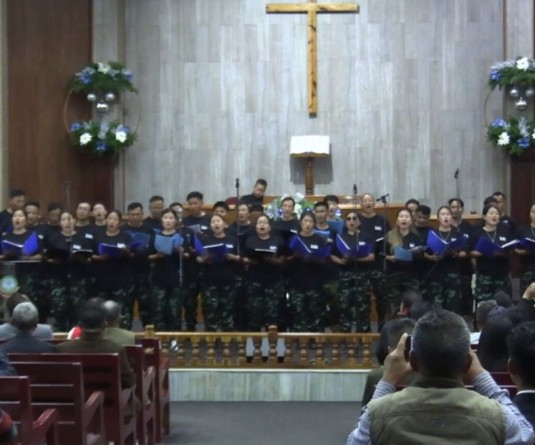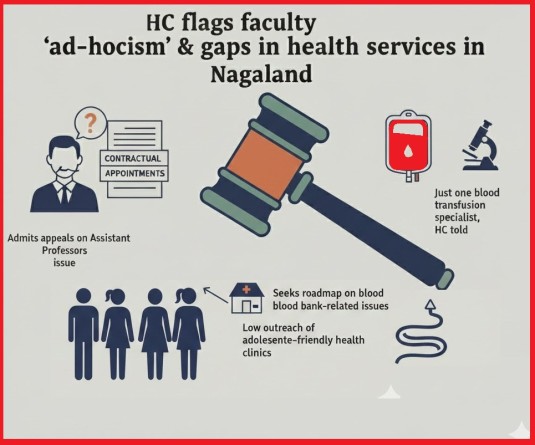
Chizokho Vero
Kohima | November 3
Governor K. Sankaranarayanan is optimistic that e-Governance and IT applications will benefit the people in Nagaland much more on account of the ‘hilly terrain’ and general feeling of remoteness both with mainland India as also within the state.
“Very often people of Mon and Tuensang feel that they are remote and cut off from Kohima and Dimapur also. This remoteness and distance can be bridged by use of technology”, he said. Having a robust IT infrastructure, with good connectivity and an offer of public services through this platform can greatly improve governance and bring the government closer to people, the governor said.
He said this would require concerted efforts by all, specially the telecom companies and “we need to improve mobile and broadband coverage in the state”. He said the “BSNL and other mobile companies will have to ensure that they reach the remotest of the villages as also cover all the national highways and state highways.” All these services and applications will also require the power department to ensure that the services are actually not affected on account of lack of power supply, governor Sankaranarayanan explained.
He maintained that the workshop on e-Governance for policy makers will go a long way in making it a priority area for all government departments and ensuring that the departments take steps to improve their public service delivery systems to benefit citizens. “Today, technology has the potential to make interactions between governments and citizens a much more satisfying experience for the citizens and this can change the normal perceptions that people have about government,” said Sankaranarayanan in his address at the capacity-building workshop for legislators and policy-makers here at the Zonal Council Hall this morning.
The governor said data collection and analysis from departments and field officers can become much more meaningful and lead to policy-formulation that is more relevant. Monitoring projects, fund utilization and preventing leakages can be achieved by the use of e-Governance applications. Communication between various government offices can be faster and more efficient. For instance, projects like e-Procurement has led to savings in the tune of thousands of crores for states like Andhra Pradesh.
However, Sankaranarayanan said, there are numerous challenges in implementing e-Governance projects in Nagaland. In states like Karnataka and Andhra Pradesh, the e-Governance boom has taken place through effective public-private partnerships which helped in leverage of technological flexibility and efficiency of the private sector in offering public services. This is achieved through very healthy competition between vendors who offer good technology at good cost. However, the governor said, in Nagaland and the North East, the private sector is hardly there and those which are providing hardware and other solutions are also unable to offer the same service-levels as done in other states.
“It is common knowledge that even reputed companies fail to comply with their own standards of after-sale services in most of the north eastern states. For offering public services, there are hardly any competitive vendors as the lower population density results in less number of transactions, in which most of the private players are not interested. This results in difficulties in getting the right technological solutions on one hand and increased cost per transaction, on the other, making e- Gov projects economically unviable and difficult to implement,” Sankaranarayanan said. He was of the view that such issues will require more innovative planning and flexibility in approach for successful e-Governance projects.
Also, Chief Minister Neiphiu Rio, stating that e-Governance has become the most versatile tool to improve service delivery to citizens and to improve governance, called upon all policy-makers to embrace it and use it as instrument to transform the system of governance to address the socio-economic challenges more effectively. Rio said that the state has great potential to benefit from the IT and ITeS revolution on account of youthful English-speaking population in Nagaland.
That the state government has framed an IT policy in 2004, Rio reiterated the mission statement to endeavor in developing the state as a preferred IT-destination by creating an enabling environment with appropriate policy intervention and people’s participation.
It shall also endeavor to use IT-based technologies to uplift the quality of life of the people of the state particularly in the rural areas. The government will also facilitate and support the creation of sound IT-infrastructure and skilled human resource thereby providing a competitive edge in attracting investment in the IT sector to promote an IT-led economy and generate employment opportunities, he said. Rio added that the state will promote e-Governance as a tool to deliver a government that is more proactive, transparent and responsive to its citizens.
In order to fulfill the objectives outlined by the IT policy, Rio said that the state has framed an e-Governance road map. As per the road map, its vision is “a vision of growth, sustainability and socio-economic welfare of citizens; armed with a comprehensive policy framework for instituting mechanisms for imparting fair justice and reinforcing the traditional systems of local self governance in order to deliver faster, reliable and transparent mode of services by leveraging IT as a tool for empowering people distanced by remoteness and handicapped by poverty.”
The state’s strategy for e-Governance comprises establishing the core IT infrastructure including State Wide Area Network (SWAN), State Data Centre (SDC) and establishing Common Services Centres at 220 locations across the state for services delivery.
The government has identified agriculture, treasuries and accounts, commercial taxes, road transport and employment for the first phase of its mission projects. In addition, health, education, rural development, industries and commerce, veterinary and animal and husbandry, tourism, personnel and administrative reforms and finance department are also to implement the state mission mode projects.
Nagaland and other states in the North East, Rio said, need more proactive support from the Government of India in implementing these projects. “In order to facilitate growth of IT and ITeS industry in Nagaland, we need capacity building of the youth to equip them with skills that will help them in getting jobs in this sector,” he said.
As part of capacity building, he said, the Government of India needs to support training of youth in IT, ITeS and BPO skill-training. Rio also said that the state government is in the process of establishing an IT park in Dimapur. The state will need help and support from various quarters to ensure that IT companies actually come forward with substantial investments in Nagaland, he said.
Rio also announced that all the 60 legislators, 11 deputy commissioners and 9 senior officers will be provided with laptops. As part of the launching, the governor, chief minister and speaker received a laptop each during the workshop today. Meanwhile, the day-two workshop (November 4) is set for joint secretaries, heads of departments and departmental IT nodal officers, which will commence from 9: 15 AM.


.jpg)



